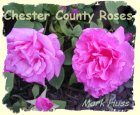Rose Articles

Rose Articles
|

|
Own-root vs. Grafted Rosesby Kim RupertThe variables governing performance of own-root vs. budded roses are too numerous to list. Suffice it to say that many roses do as well on their own roots as they do budded, but not all. A few, most notably, Iceberg, actually seem to do better on their own roots here in Southern California. Iceberg develops its natural shape, which is by far more disease resistant and attractive, on its own roots. My preference has long been own-root, but not everything is available that way, and too many of the obscure roses I want to grow just don't perform well that way. If the plant isn't vigorous budded, it will likely be a "dog" as an own-root. How Budding StartedWith very few exceptions, if a rose variety was introduced prior to the 1920s, it was probably introduced as an own-root plant and necessarily had to perform well that way. It wasn't until then that the "Big Boys" began pushing the budded plant issue in order to differentiate themselves from the smaller producers. Once budding became the preferred method of propagation, it didn't matter how the rose performed own-root. The point was moot. Commerical ProductionAs you may know, the current trend is back to own-root production as it produces a virus-free plant (assuming original virus-free material) at a lower cost. This is true because you know exactly how many viable plants you are going to have in the field once they are mature, while budding does lead to some failures. Budders (people who bud roses) are expensive, and not that reliable. The causes range from weather, follow up, budwood condition, etc. While the initial cost of the greenhouse, controls, etc., are greater, cuttings can be produced at significantly lower cost per unit. Once these root, and the percentage is usually in the 100% range, the plants grow quickly. You can produce many times more plants per stock plant, much more quickly, and know what you have before committing the real estate, which is the real expensive part. The plants are already vigorously growing prior to setting out in the field, and there are no root stock tops to bend, break or remove, plus, no root stock suckers. The scion can't be ripped out of the root stock as we witnessed so often this January in Wasco, and there aren't the lethal damages often done during harvest. As the plant is a "plug" with plenty of roots, putting it in the field is merely a transplant operation, which is far more vital and less fragile than a bud inserted under the bark of a larger root stock plant, and won't suffer the failures due to irregular irrigation a budded stock will. The benefits are just too many to ignore. Garden AdvantagesOnce in the garden, the typical dummy home owner/mower-blower is far less likely to destroy the own-root plant through sloppy planting and pruning, and the plant should theoretically live forever, as the root stock won't overtake it. There is less knowledge necessary to maintain it in a vital, vigorous condition. Own root plants often divide, like Mums, and therefore are more easily propagated and kept in the garden. Budded plants, in a perfect world, have had their lives estimated at around twenty to twenty-five years, before they become too arterially schlorotic to produce. There isn't that problem with own-roots as they continue to throw new basal breaks around the perimeter of the plant, which will lead to a dead center, and much new growth surrounding it. Hence, the benefit of occasional digging and dividing, much the same as you would do with an older miniature rose plant. So, in many cases, own root is better. But still, not in all cases. Infant MortalityThe primary problem with own-root roses is they are normally purchased as infants, in small pots. If put directly in the ground, they often don't flourish. On the other hand, if held in a five gallon can, planted in rich soil, kept in a prime spot for heat and sun, overfed and over watered, and not allowed to bloom, they frequently develop into healthy plants which will explode into growth and bloom once well planted. So, the basic problem today with own root plants is that they are immature, but not treated as such, so they fail. This is like drying out a budded bare-root rose, planting it badly, then blaming budded plants for the failure as they are "inferior". Mr. Rupert is a rose collector and part-time rose breeder who lives in sunny SoCal. His wonderful rose "children" are available from Ashdown Roses in NC. |